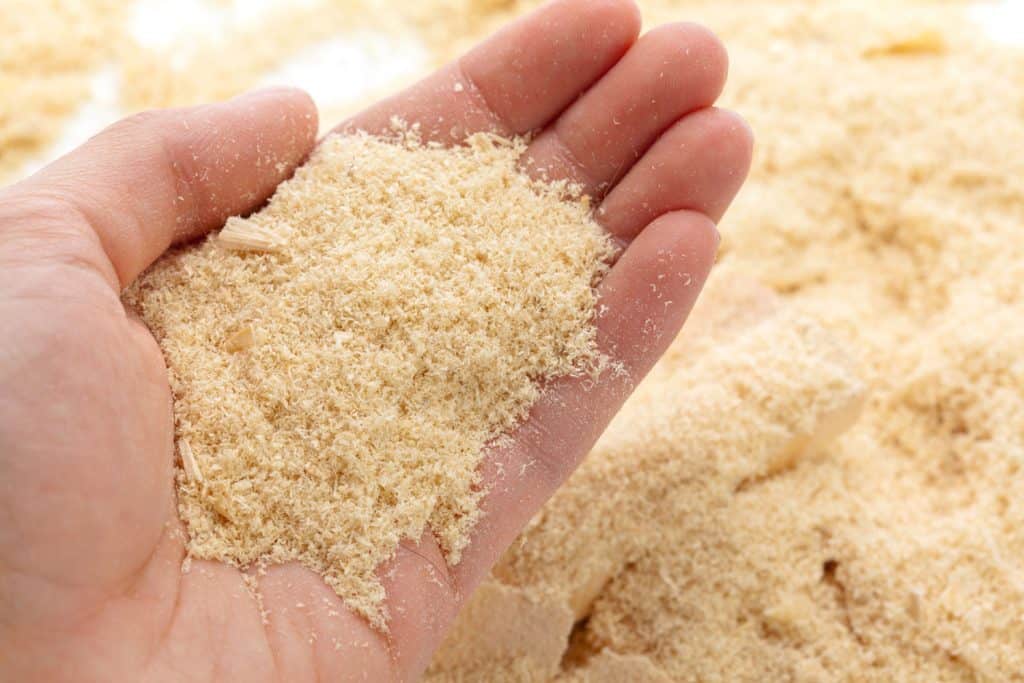A hole can appear in a plywood door. It can happen because of different reasons such as accidentally pressing a ladder into the material. So the question is, how can you repair a hole in a plywood door? We researched this question for you and here’s what we found.
Follow these steps to fix a hole in a plywood door:
- Make the hole slightly larger and fill it with paper and insulation.
- Apply auto-body filler or polyester resin onto the problem area and trim the excess.
- Wait until dry and sand it with sandpaper.
- Place spackle or joint compound on the area of activity before applying a coat of paint.
It shouldn’t take a significant amount of time and effort to complete this repair project. But you might make mistakes if you don’t know certain details to complete this task efficiently. Keep reading to learn the essential pieces of information about fixing a hole in a plywood door.

Can You Patch A Hole In Plywood?
It’s possible to patch a hole in plywood provided that the problem area isn’t extensive. If the damage is fairly large, you may need to replace a large section of the wooden board. Otherwise, it might be more convenient on your part to replace the entire plywood sheet instead.
How Do You Fix A Hole In A Plywood Door?
In this section, we’ll lay out each item needed to help you fix a hole in your plywood door. We’ll also tackle the necessary steps to complete this project properly.
What You’ll Need
- Utility knife
- Paper or paper towel
- Low-expansion aerosol foam insulation
- Auto-body filler or polyester resin
- Putty knife
- Sandpaper
- Spackle or joint compound
- Paint
Step-By-Step Guide
- Use a utility knife and cut around the bevels of the edge of the hole.
- Insert a piece of crumpled paper or paper towel into the gap.
- Fill the hole with low-expansion aerosol foam insulation.
- Press the foam into the hole as firmly as possible.
- Wait for the foam to dry and trim the excess with a knife.
- Mix auto-body filler or polyester resin using its two parts, which are the main substance and a catalyst.
- Apply the mixture over the foam with a putty knife.
- Wait until the solution attains a rubbery consistency.
- Trim off the excess filler or resin afterward.
- Sand the surface until smooth using 100-grit sandpaper.
- Apply a coat of spackle or joint compound, then smoothen the substance with a putty knife.
- Wait for the spackle or joint compound to be dry and sand the surface with 100-grit sandpaper again.
- Apply a coat of paint with the same color as the door.
If you wish to spray paint the door after fixing the hole, the following post can guide you in that regard: How To Spray Paint A Plywood Door?
Also, take note that it should roughly take an hour to complete this task, provided that you already have the necessary materials. You can also check out the video below for a visual representation of the steps mentioned above:
Check out this Touch ‘n Foam Home Seal minimum expanding foam on Amazon.
How Big Of A Hole Can Be Filled With Wood Filler?
The amount of wood filler usable to seal large holes often depend on the product’s composition. For example, cellulose wood putty isn’t ideal to fill holes larger than 3/8 inches.
Traditional wood fillers that use a mixture of white wood glue and sawdust should also work well in holes up to approximately the same diameter. On the other hand, two-part epoxy fillers might plug holes larger than 3/8 inches.
Check out this PC Products PC-Woody Wood Repair epoxy paste on Amazon.
Can You Use Wood Putty Instead Of Wood Filler?
Use wood fillers, particularly low-expansion models, for indoor wooden structures like bedroom and pantry doors. On the other hand, wood putty is better for exterior woodworks since it generally doesn’t harden.
Instead, wood putty contracts and expands to conform with the shape of the material, allowing the substance to adapt to changes in weather or temperature.
Furthermore, take note that wood fillers usually dry faster than woody putty. Therefore, fillers shouldn’t cause significant harm to different woodworkers if you apply more than the recommended amount.
What Can You Use Instead Of Wood Filler?

You can use a mixture of wood or Elmer’s glue and sawdust to create a DIY wood filler. Make sure to combine the ingredients in a disposable container like a paper bowl or plate.
It’s important to note that the appearance of the finished seal will most likely be different than the surrounding wood. However, you can still sand and paint this DIY filler to match the wooden structure.
Check out this Gorilla Ultimate Waterproof wood glue on Amazon.
How Do You Fix A Door That Has A Broken Hole?
Patching a relatively small hole in a door is fairly easy. As for fixing a door with a cracked or chipped hole, the steps are similar albeit some differences exist. Find here below the necessary tools and procedure for this project:
What You'll Need
- Gloves
- Wood filler
- Putty knife
- Screwdriver
- Vacuum cleaner
- Low-expansion foam insulation
- Auto-body filler
- Hammer
- Paint roller or paintbrush
- Paint or wood stain
- Sandpaper (100-, 120-, 220-, and 320-grit options)
- Sponge or paper towel
Step-By-Step Guide
- Prepare the crack or hole by cleaning it. Use a vacuum cleaner to remove loose debris, such as dust and splinters.
- Grab and crunch paper towels and fill the gap with them.
- Spray low-expansion foam insulation into the hole. Let it dry and trim the excess.
- Sand the remaining insulation with 320-grit sandpaper.
- Apply auto-body filler over the insulation and let it dry.
- Sand down the mixture of insulation and auto-body filler with 100-grit sandpaper. Then, use the 120-grit and 220-grit sandpaper to smoothen the surface.
- Use a screwdriver and unscrew the handle, doorknob, and other hardware from the door. Remove the entire doorway if necessary.
- Apply a coat of paint to the patched area.
- Let the paint dry before adding extra coats.
- Return the door to its frame.
You can also watch the video below if you need to see the steps mentioned above in action:
Additionally, check out this post if you want to learn how to fix a hole in an oak door: How To Fix A Hole In An Oak Door
How Much Does It Cost To Fix A Hole In A Plywood Door?
HomeAdvisor explains that fixing a hole in a door, regardless of its material, will have costs ranging from $100 and $1,000. However, it might be more cost-effective to replace a plywood door if the gap is fairly large and requires more filler than average to seal.
For example, you can save money by buying a quality sheet of plywood, which costs about $502.30 as of March 2021, instead of trying to complete a $1,000 door repair job. Moreover, the savings can increase if you opt to avoid professional help and complete the fixes using DIY techniques.
But if you want to proceed by taking advantage of expert assistance, prepare to spend $375 to $1,125 to install interior doors and $525 to $1,700 to assemble exterior doorways.
Final Thoughts
Repairing holes in plywood doors requires essential materials and pieces of equipment to complete the project with minimal errors. Make sure to gather things like a low-expansion aerosol foam insulation, an auto-body filler, and a joint compound.
If done correctly, this project shouldn’t even take an entire day to finish.






